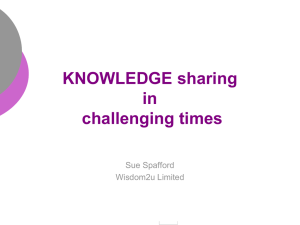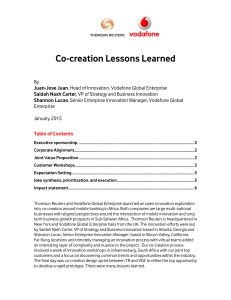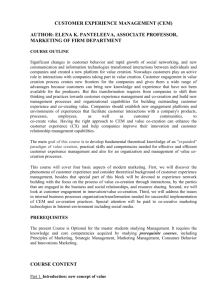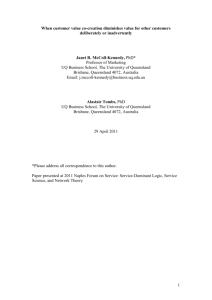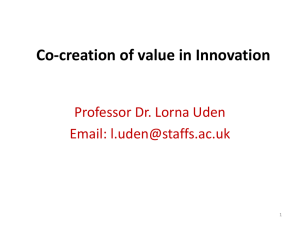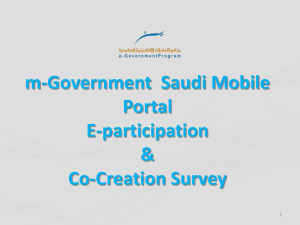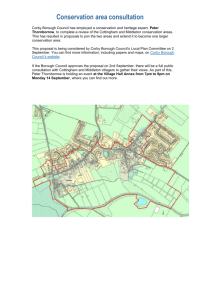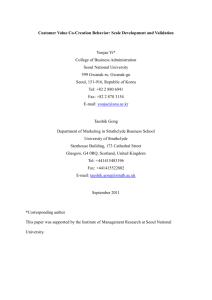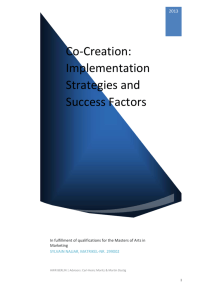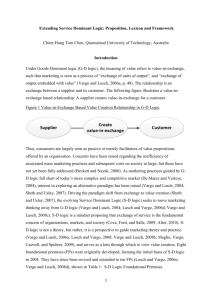Understanding Complex Service Systems Through Different Lenses
advertisement
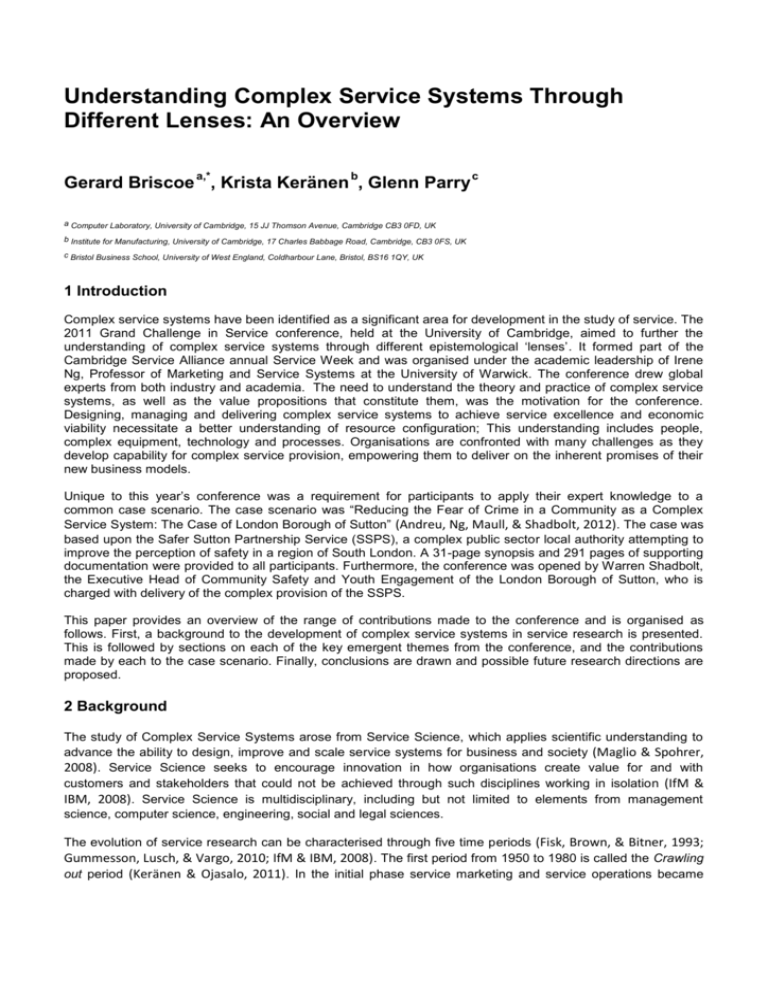
Understanding Complex Service Systems Through Different Lenses: An Overview Gerard Briscoe a,*, Krista Keränen b, Glenn Parry c a Computer Laboratory, University of Cambridge, 15 JJ Thomson Avenue, Cambridge CB3 0FD, UK b Institute for Manufacturing, University of Cambridge, 17 Charles Babbage Road, Cambridge, CB3 0FS, UK c Bristol Business School, University of West England, Coldharbour Lane, Bristol, BS16 1QY, UK 1 Introduction Complex service systems have been identified as a significant area for development in the study of service. The 2011 Grand Challenge in Service conference, held at the University of Cambridge, aimed to further the understanding of complex service systems through different epistemological ‘lenses’. It formed part of the Cambridge Service Alliance annual Service Week and was organised under the academic leadership of Irene Ng, Professor of Marketing and Service Systems at the University of Warwick. The conference drew global experts from both industry and academia. The need to understand the theory and practice of complex service systems, as well as the value propositions that constitute them, was the motivation for the conference. Designing, managing and delivering complex service systems to achieve service excellence and economic viability necessitate a better understanding of resource configuration; This understanding includes people, complex equipment, technology and processes. Organisations are confronted with many challenges as they develop capability for complex service provision, empowering them to deliver on the inherent promises of their new business models. Unique to this year’s conference was a requirement for participants to apply their expert knowledge to a common case scenario. The case scenario was “Reducing the Fear of Crime in a Community as a Complex Service System: The Case of London Borough of Sutton” (Andreu, Ng, Maull, & Shadbolt, 2012). The case was based upon the Safer Sutton Partnership Service (SSPS), a complex public sector local authority attempting to improve the perception of safety in a region of South London. A 31-page synopsis and 291 pages of supporting documentation were provided to all participants. Furthermore, the conference was opened by Warren Shadbolt, the Executive Head of Community Safety and Youth Engagement of the London Borough of Sutton, who is charged with delivery of the complex provision of the SSPS. This paper provides an overview of the range of contributions made to the conference and is organised as follows. First, a background to the development of complex service systems in service research is presented. This is followed by sections on each of the key emergent themes from the conference, and the contributions made by each to the case scenario. Finally, conclusions are drawn and possible future research directions are proposed. 2 Background The study of Complex Service Systems arose from Service Science, which applies scientific understanding to advance the ability to design, improve and scale service systems for business and society (Maglio & Spohrer, 2008). Service Science seeks to encourage innovation in how organisations create value for and with customers and stakeholders that could not be achieved through such disciplines working in isolation (IfM & IBM, 2008). Service Science is multidisciplinary, including but not limited to elements from management science, computer science, engineering, social and legal sciences. The evolution of service research can be characterised through five time periods (Fisk, Brown, & Bitner, 1993; Gummesson, Lusch, & Vargo, 2010; IfM & IBM, 2008). The first period from 1950 to 1980 is called the Crawling out period (Keränen & Ojasalo, 2011). In the initial phase service marketing and service operations became distinct from goods marketing and operations. Much of the research and discussion focus on the question of how services differ from goods. The classic distinctions between services and goods are intangibility, heterogeneity, inseparability (simultaneous production and consumption), customer participation and perishability (Shostack, 1977). The second period from 1980 to 1985 is called the Scurrying About period (Fisk, et al., 1993; Keränen & Ojasalo, 2011). During this time a distinct group of service academics and business practitioners developed (Grönroos & Gummesson, 1985; Lovelock, 1984; Shostack, 1981). Services research moved beyond the goods and products dyad, although it remained strongly conceptual. Example literature highlighted the need to manage personnel involved in the service experience, the physical aspects of the service and the process by which the service is delivered (Booms & Bitner, 1981). The third period between 1986 to 1992 is called the Walking Erect period (Fisk, et al., 1993; Keränen & Ojasalo, 2011). Several models describing the process of new service development emerged (Bowers, 1986; Donnelly, Berry, & Thompson, 1985; Scheuing & Johnson, 1989). Other topics included service quality (Grönroos, 1983; Parasuraman, Zeithaml, & Berry, 1985), the design and management of service production and encounters (Czepiel, Solomon, & Surprenant, 1985; Eiglier & Langeard, 1987), and the role of intangibles and the physical environment in the customer’s evaluation of the service (Hui & Bateson, 1991; Larsson & Bowen, 1989). The fourth period from 1993 to 2000 is called the Making Tools period (IfM & IBM, 2008; Keränen & Ojasalo, 2011). Service research becomes more quantitative, to include measurement, statistics and decision support modelling. Expanded topic areas included service productivity (K. Ojasalo, 1999), service supply chains, service recovery, technology infusion and service computing. Customers are a focal point, and topics include service experiences, service quality and customer satisfaction, connecting operational factors that affect quality to customer loyalty, and service orientation (IfM & IBM, 2008). The turn of the millennium denoted the start of the fifth period, called the Creating Language period (IfM & IBM, 2008; Keränen & Ojasalo, 2011). New models of service emerge, and the concept of service systems develops, which unites different perspectives within service science. The field expands rapidly with increasing numbers of researchers, conferences and networks, while initiatives such as Service Science Management and Engineering (SSME), introduced by IBM, aim to strengthen interactions between industry, academia and government (Hefley, Hefley, & Murphy, 2008). Service science has come to include the application of scientific understanding to advance service design capability and improve service systems for business and societal purposes (Maglio & Spohrer, 2008). The Service-Dominant logic view (Gummesson, 2008; Vargo & Lusch, 2004, 2008), service logic view (Grönroos, 2008, 2011) and the goods logic view of services gradually replace the traditional goods-versus-services dyad. Increasing applied service research is undertaken with manufacturing companies, because of their transition to the service-oriented approach to offer comprehensive customer solutions (J. Ojasalo & Ojasalo, 2008). The University of Cambridge hosted the first Grand Challenge in Service conference in 2010, officially launching the newly founded Cambridge Service Alliance. The conference featured a week of events and received support from the Cambridge Service Alliance, Advanced Institute of Management (AIM), University of Exeter Business School, Rolls Royce, Manchester Business School, UK network of Service Science Management and Engineering (SSMEnetUK) and the University of Arizona’s Eller College of Management. It brought together leading academics, industrialists and policy makers to address the evolving challenges facing service education, research, practice and policy. The hope was for future service research to move towards an integrated agenda to better understand how people, processes and assets interact within complex service systems for the co-creation of value with customers. The challenge was to organise the interdisciplinary research environment to achieve greater relevance and impact to industry and society. This included how research could be better transferred to practice. The discussions informed the topics and format of the 2011 conference, and led to the integrating concept of a shared case scenario. At the 2011 conference, leaders in the field created an expert panel of service systems thinkers who provided presentations at the start of each day. The conference then divided into nine sessions from which the following key themes arose; Value Co-Creation and Collaboration, Systems and Networks, Information and Communications Technology (ICT), and Complexity. Their contributions and links to the case scenario are presented in the following sections. 3 Value Co-Creation and Collaboration According to Spohrer and Maglio (2010) service is value co-creation. Service science is the study of the useful change that results from communication, planning, or other purposeful and knowledge-intensive interactions between distinct entities. To collaborate, two or more people, institutions, firms or societies need to associate with each other. During a company’s interactions with a customer it has the opportunity to engage with the customer’s value creation system and become a co-creator of value (Grönroos, 2011). There can be multiple points of customer-company interaction in the system, and all are opportunities for value creation (Ng & Briscoe, 2011; Prahalad & Ramaswamy, 2004). Many contributions to the co-creation phenomenon include empirical evidence and address several different topics. Value resonance among stakeholders, was presented by Sebhatu, Johnson, Gebauer and Enquist. Value resonance arises when company, foundation and customer values align; an important factor when creating meaning among actors in a complex service system. For example, IKEA and Starbucks attribute success to ensuring such alignment in their value-based service businesses. It is important that customer and company values resonate, and companies draw not only on customers’ values but also company culture, leadership and governance. Companies achieving value resonance base values on brand and develop interactive communication through dialogue between all parties. Vyas and Young considered how service providers can display pro-social behaviour, initiating and coordinating a service for the wider community from a city or region. Pro-social behaviour utilises socially responsible design as a means to assist collaborative approaches for community engagement. To create value in many-to-many service contexts a structured approach to mass service creation in networks is necessary. One recommendation was to encourage case research and ethnography, so as to better understand how customers interact with one another to create value for themselves and others. A variety of views were put forward for what is and what is not value co-creation. A concern was that drawing too narrow a view would be unhelpful. Equally, if all value is co-created the concept becomes generic to the point of redundancy. A consensus was reached by considering the development of a model consisting of different levels of co-creation. Accepting that value is always co-created, then the degree of co-creation changes dependent upon the focus of the system, which encompasses levels within a model. This leads us to consider the next key theme that arose from the conference, that of systems and networks. 4 Systems and Networks Systems theory has garnered increasing attention within service research, making contributions to the understanding of service phenomena (S. Barile & Polese, 2010). A service system is shaped by forces in the wider social system. So, an unbounded approach to service system analysis allows researchers to go beyond the conventional frames of reference. This can then allow them to consider a collection of factors that are inseparably linked (Banathy, 1996). Therefore, service system frameworks allow researchers to conceptualise and analyse the network of interactions that define service. At the conference contributions ranged from fundamental efforts to understand service systems to specialised efforts to understand individual industries, such as the automotive industry. The fundamental contributions were aimed at understanding service systems, boundaries, and the dynamics of their interactions with the social systems in which they exist and symbiotically sustain through emergent value constellations. The approaches presented were aimed at encompassing multiple perspectives, making use of conceptual, modelling and computational frameworks. Some approaches were based in structuration theory (Giddens, 1984; Sewell, 1992), while others on the theory of fuzzy systems. Others provided an understanding of the structures within service and social systems, and their influence in creating competitive value propositions. Ontological models of services were also presented that considered the interrelations of states, events and processes occurring in wider service systems. Other contributions sought to better understand what enables service innovation within the networks of interactions that make up service systems. The more reflexive contributions developed an appreciation of the interactions between services and their impact on surrounding social systems. It was also proposed, based upon critical realism, that fragmentation from functional division could prevent the actors of a system from seeing the wider system of networked interactions. So, augmenting the actors’ relationships with additional information could allow more accurate perceptions. The implications of the viable systems approach was presented by Barile, Polese, Saviano and Di Nauta. Their work explored the boundaries to identifying governance approaches and establishing sustainable relationships among the actors, sharing knowledge and valorising common resources. They started with a theoretical discussion of the concept of boundary, and its implications to service systems understanding from a systems theory perspective (Parsons, 1971; Von Bertalanffy, 1950). Then a Viable Systems Approach (AA.VV., 2011; Golinelli, 2002) was adopted, considering recent advances in Service Science (Maglio & Spohrer, 2008) and Service-Dominant logic (Vargo & Lusch, 2008). Wider and more porous systems boundaries were then proposed, to better understand governance mechanisms and managerial behaviour. This exemplified the notion that organisations are open to external dynamics and need to interact with many actors (owners of needed resources) in the pursuit of value co-creation. Simulation of service systems by integrating models and data of component systems into bigger and more encompassing models was presented by Kieliszewski, Maglio and Cefkin. The platform takes models of realworld systems, synthesising and integrating them into an interoperating composite system model. Policy-makers can then use the model to evaluate alternative scenarios, and understand the difference between current and idealised approaches to achieving sustainable change. This work takes service system analyses beyond individual provider-customer dyads and considers entire value constellations, providing mechanisms for cataloguing, describing, and connecting diverse sets of models together. Understanding service provision requires a system perspective to better understand the networks of interactions through which services emerge. This is driven by the increasingly complex nature of these technology augmented networks. This leads us to the next key themes, technology and complexity. 5 Information and Communications Technology The services industry is of increasing importance to the global economy, with many technology augmented services delivered through complex networks of service providers. For example, the United Kingdom (UK) government published a paper acknowledging the development of electronic services as key in the UK economy (Pryor, 1999). So, advances in technology are facilitating greater connectivity between entities, in which services are hybrid offerings of physical assets, information and people. While the network aspect in services has been established, increasing connectivity is leading to ever greater complexity, for which technology (ICT) can be both the cause and the cure. The myriad of services that are ICT dependent or enabled continues to grow. Furthermore, maintaining an awareness of the changing state-of-theart is critical because of the ever increasing pace of change. For example, new paradigms such as Cloud Computing1 are providing opportunities to improve the delivery of ICT-enabled services. At the conference most contributions were aimed at using technology to help manage the increasing number of large, complex service systems. This included approaches being developed to understand how the use of technologies can lead to the creation of complex service networks, arising from the increasing pervasiveness of ICT (e.g., smartphone applications and broadband Internet). Other approaches made use of model-based and process-tree-based learning to better understand and manage the acquisition of information requirements, trust issues, and aspects of quality of service. Consideration was also given to how technologies significantly stretch the scope for knowledge management generally, and in digital government specifically. Other contributions 1 Cloud Computing is a marketing term for technologies that provide computation, software, data access, and storage services that do not require end-user knowledge of the physical location and configuration of the system that delivers the services. A parallel to this concept can be drawn with the electricity grid, wherein end-users consume power without needing to understand the component devices or infrastructure required to provide the service (Marinos & Briscoe, 2009). showed that the transfer and utilisation of knowledge are important for organisational life and growth. This can be faciltiated by the adoption of new technologies, increasing the efficiency of transfers across and between organisations, and so has the potential to accelerate the diffusion of innovation. Furthermore, digital environments allow differentiation in the services delivered to a diverse range of users. However, it therefore also presents new organisational challenges because of the complexity that can arise from the increased variety. ICT-enabled services and service innovations are said to be critical to achieving long term competitive advantages. So, existing and expected impacts of new technology paradigms were considered. Busquets et al. presented forms of social networking which will become a central element in the client strategies of customercentric organisations. Financial institutions were also considered; Banks seeked to better understand customer intentions through social media and digital platforms when promoting innovations in complex services. These complex services are important, because they allow banks to differentiate and de-commoditise offerings (Cusumano, 2010). Rajala, Tuunainen and Cassab considered the paradigm of service modularity made possible by ICT platforms. This includes the concept of service modularity in the design of ICT-enabled services, and the business models required for them. Insufficient attention had been paid to the connection between business model design and service modularity. This is despite prior research showing that modular product design and organisational ambidexterity contribute to product innovation capability (Tushman & O'Reilly, 2006). Their approach involved integrating theories of strategic orientation and organisational learning, from the innovation management literature, with research on service design, information systems and business models. A framework was then proposed for investigating service modularity for ICT-intensive service innovations. This research-in-progress framework has four elements, considered as building blocks in a modular design of any ICT-enabled services: (1) the service offering, (2) resources, (3) the revenue model, and (4) the relationships with intra- and interorganisational actors. Consideration was then given to how the framework could be used to benchmark organisational efforts towards modular service design and to meet the management challenges associated with ICT-enabled services. Cloud Computing provides a compelling value proposition for organisations to out-source their ICT infrastructure (Briscoe & Marinos, 2009). However, the transformation of an organisation’s or a community’s ICT-enabled service systems to a Cloud-Computing-based service model is a complex process. A study presented by Su aimed to create a conceptual framework to facilitate the understanding of such service systems and their transformation towards the Cloud Computing paradigm. Su develops a framework to conceptualise Cloud Computing within the broader service ecosystem. Such a service ecosystem consists of diverse stakeholders with different options for acquiring different services. This service ecosystem is dynamic as an increasing number and variety of services can utilise Cloud Computing. The more standardised, automated, and commoditised services are, the more likely they will be transformed into the self-served on-demand utility-model that the Cloud Computing paradigm represents. The realisation of ICT-enabled services builds upon the increasingly interconnected networks of providers required to enable the necessary service innovation. However, these can only be fully understood and realised with an appreciation of the complexity that arrises from their interconnectivity, the next key theme to be discussed. 6 Complexity Complexity within service systems generally arises from their increasing scale and number of components. It is proposed that understanding complex service systems benefits from a systems perspective and a wide knowledge base. This conference has helped establish a knowledge base through the creation of a network of professionals from different fields to explore, analyse and evaluate complex service systems from different perspectives. The case scenario, the SSPS involves over 30 organisations and is recognised as a complex service. However, complexity can exist even in a relationship between only two parties. Complex systems are constantly adapting, and their interactions can have emergent effects upon outcomes, which are sometimes unpredictable. This unpredictability requires understanding if we wish to develop sustainable complex systems. Typically too much emphasis is placed on the static nouns of a system, instead of the dynamic verbs which are more significant in facilitating the understanding of complex outcomes. Considering the research presented during the conference, even understanding, analysing and modelling complex service systems can be challenging. The work presented aimed at addressing the perceived knowledge gap in understanding how institutions, firms and society interoperate with dynamic complex service systems. Questions raised during the discussions sought definitions for ‘intelligent’ complex service systems, and how they might help in achieving the stated aim. A three step approach to management of complex service systems was presented by Parry, Mills and Purchase. The research was part of a study into the provision of military jets under an availability contract and described tools developed to pragmatically fulfil the needs of service managers. The approach integrated value analysis, the creation of an image capturing the organisations involved, and an approach to identify and address the complexity challenges. This work highlights that complex service systems place heavy reliance on relational exchange to achieve enterprise goals. Complexity analysis was built upon the premise that complexity is a hindrance to system performance and that companies are engaged because of their capability in managing specific complex service systems. Empirical analysis further identifies six core areas likely to be source elements of complexity; operand resource, operant resource, financial, process, contractual, and organisational. These were presented to managers as a guide to where complexity might exist. This enables limited resources to be better focused when undertaking targeted change activity. A detailed visual representation of complex public sector service provision was presented by Mills, Purchase and Parry. This work further develops the concept of Enterprise Imaging 2 and provides descriptions of how a complex service system may be captured. The image framework creates a central front office area, with a back office above and below it, which represents the two main contracting parties. Individual units are drawn upon the framework, placed appropriately in the front or back office depending on visibility to the other parties. These organisational units together undertake activity to co-produce service outcomes. The ‘final’ image was an epistemic object around which discussion and strategy could be built, instead of a factual representation of an enterprise. The approach was applied to other complex service systems, including fast jet support, UK National Health Service (NHS) psychiatric intensive care provision, and the SSPS case scenario. Each organisation involved stated how creating the image was as valuable as the image itself when understanding and contextualising their complex service systems. Angelis, Parry and Macintyre presented work focused upon discretion and complexity in customer focused environments. Operations have traditionally focussed on reductive analyses in which transactional processes are open to mass-customisation and standardisation. This work proposes that service complexity created by extensive reasonable customer demand limits the ability to standardise and manage systems through masscustomisation. Beyond mass-customisation it is proposed that management is achieved through discretion, which is difficult, if not impossible to codify. Operations are necessarily managed by framework principles, and these must be embedded in culture. This result creates numerous challenges for managers because whilst culture provides a source of sustainable competitive advantage it is difficult to replicate and scale across firms. The conclusion proposes that service complexity created by extensive ‘reasonable’ customer demand limits the ability to standardise and manage systems through mass-customisation. The first steps have been taken in understanding, managing and analysing the complexity that can emerge in service systems. The range of contributions shows that the challenge affects many areas of research, although often in different ways. So, the opportunity to address the challenge collectively under a common theme, such as the shared case scenario, offers a possible way forward. 7 Case Scenario Warren Shadbolt, the Executive Head of Community Safety and Youth Engagement of the London Borough of Sutton, describes the challenge of complex service provision as a public sector provider. The London Borough of Sutton is a typical middle-class affluent suburb which could be found in any large developed city. Whilst overall described as affluent, northern areas of the borough would be described as deprived based on many 2 Enterprise Imaging is a development of service blueprinting but includes multiple back office functions to support a common front office where a service is co-produced (Mills, Crute, & Parry, 2009). different public metrics such as teenage pregnancy, though not necessarily crime. The borough has many educational establishments and is a net importer of about 3000 people daily. The Sutton borough is not eligible for any special government funds to deal with specific issues, because of its overall affluent nature. However, crime is described as relative, with around 30 reported cases per day. This could have life-changing implications on many people in the borough, and therefore is a social concern. The crime level was identified as the top priority by residents in an independent annual Ipsos MORI 3 survey, which has been funded for over 22 years by the borough council. During the most recent survey, 50 percent of residents had no concerns, providing evidence of the success of the SSPS initiative. The desired result is an improvement in the perceived safety of the borough, which creates some challenges. For example, gatherings of groups of youths are perceived as threatening but are not actual criminal activity. This understanding highlights the difference between perceived and actual crime, both of which require attention. SSPS is primarily a Police and local Council initiative, with 250 staff working in a holistic blended organisational framework, but consumes only 0.5 percent of the boroughs total revenue budget. This council is believed to be the only one working in this way to co-produce a service. Mr Shadbolt identifies value co-production as a key differentiator in improving the experience of living in the borough, as measured by the survey over five years relative to other boroughs. This key differentiator is described as working with the community to define solutions. Real benefits are gained through the co-location of service providers, data sharing and objective sharing. Partnerships are described as built on trust, and so continuity of relationships between parties is important. The changes achieved were hard won, with many resistant to the new ways of working. Empowerment is held as a key driver, though this is challenging to realise as the public sector has many systems to dampen spending and reduce risk, which can therefore limit individual discretion. Contributions to the case scenario from the key themes aimed to address the underlying factors in the complex service system that the SSPS represents. These contributions are summarised in Figure 1. One of the most ambitious contributions was from a group of doctoral students. Aitken, Sahit, Wise, YanezArenas and Paton viewed the case scenario as an opportunity to offer unique perspectives free from the possible experience bias of more senior peers. They endeavoured to present a collection of fresh approaches that together would provide a complete perspective. Each approach ultimately offered a slightly differing interpretation of the case scenario, but all followed a service science theme, ranging from knowledge management to social theory. One approach, centred in service ecology, proposed that the perception of fear is the fundamental problem. Brown suggested empowering individuals within local communities, while simultaneously identifying individuals who might have been overlooked for additional attention. Andreu, González-Gallarza and Arteaga focused on the safety in the community. They analysed the risk and safety perceptions of a complex service system using multidimensional scales applied to the citizens. In addition, they considered the perception of other stakeholders in the community. Their research methodology analysed perceived safety within a complex service system through both intra- and inter-variable approaches. Specifically, they considered the use of an index which integrates the multidimensional features of residents’ perceived safety and their interactions with other stakeholders. Their research model suggested analysing the relationships between perceived safety and other social variables; i.e., satisfaction in the community, social cohesion, quality of life, social participation for value co-creation, etc. This dual methodology provided important insights into how the fear of crime can be subjectively assessed by different audiences. Furthermore, it offered the possibility of making objective comparisons, which could be useful for future planning. Vargo adopted a Service-Dominant logic approach to explore the residents’ perceptions, which had emerged from their lived experience. Making use of a customer experience modelling framework; residents’ interactions with other actors were identified. This included other factors that might enable or inhibit those interactions. The actual causes for the fear of crime, and its changing levels over time, were determined in each of the different council wards. Categorisation of the negative emotions, and how they change over time, could enable the residents and governing bodies to work together more effectively to tackle the identified experience inhibitors. Also adopting a value co-creation approach, governing bodies could regularly update their understanding of 3 Ipsos MORI is the second largest market research organisation in the United Kingdom, formed by a merger of Ipsos UK and MORI, two of the Britain's leading survey companies. Ipsos MORI conduct surveys for a wide range of major organisations as well as other market research agencies. residents’ experiences. They could then work with the residents to potentially prevent future rises in fear within communities. The consensus from the different key themes centred on understanding the psychological aspects of fear, community dynamics, emergent properties, and their interconnection. This consensus is exemplified by the individual contributions mentioned. This also showed the multidisciplinary 4 nature of the work, which resulted from the challenge of different disciplines attempting to understand the shared case scenario. So, we hope this work will encourage future interdisciplinary 5 efforts in understanding this and other complex services systems. 4 Multi-disciplinary refers to knowledge associated with more than one existing academic disciplines, such that a multi-disciplinary community can decompose a problem into nearly separable sub-parts, and then addressed via the distributed knowledge in the community. 5 Inter-disciplinary refers to new knowledge extensions that exist between or beyond existing academic disciplines, such that an inter-disciplinary community engaged in creating and applying new knowledge becomes a primary sub-goal of addressing the common problem. Value Co-Creation and Collaboration Suggestions included that both the community and the SSPS committee should focus more on value co-creation and coproduction, rather than contractual obligations. Considering renewal and values resonance, it was suggested that an involvement of the community (customer) in the production of the service (safety) is a more effective and efficient instrument of value co-creation. The role of design can also help to co-resolve concerns about anti-social behaviour, by seeking to promote greater collaboration and mutual understanding between the stakeholders (police, council staff, residents and youths) to realise an improved level of social wellbeing through co-design. There is a need to identify service creators and customers and discuss the boundaries between the two, because service systems are established to create services with different parties playing an active part in service creation. Customers could become service providers to others. Systems and Networks Contributions ranged from considering communicative barriers that might exist from functional divisional within the SSPS to possible dialogues that could be fostered among the actors to encourage constructive service innovation. Given that the key issue is the fear of crime, which is essentially psychological in nature, it could be investigated with a coherent interpretation scheme from a viable systems information variety model (S Barile & Saviano, 2011), such that the interpretation schemes could determine the perceived relevance of significant information flows within the system. An approach suggested was that the governance actors within the London Borough of Sutton (Municipality, Safer Neighbourhood Inspectors, Ward Councillor, Resident Association Representative, Street Scene Manager, Council Manager) ought to adopt a citizens’ viability perspective and so direct governance actions in a sustainable way, investing resources to monitor context conditions that help determine the fear of crime. Information and Communications Technology Contributions ranged from considering the role of ICT in achieving the sustainable development of local communities generally, to the potential of creating online communities that can reshape the relationship between different stakeholders of local communities. A possible issue identified was that of trust with the council’s ability to carry on tackling crime even though the statistics show that the local authority has been performing well in this area over the few last years. A potential approach considered was the realistic application of ICT-enabled social networking for service innovation, exploring aspects such as culture and innovative contexts for extrinsic motivations relative to social obligations in helping to manage crime and the fear of crime. Complexity A significant recommendation was the application and integration of three different approaches (Enterprise Imaging, Value definition, Complexity Analysis) to provide a holistic view of the challenges that need to addressed. For example, reducing the fear of crime can be regarded as an emergent consequence of a complex service system, where the outcome (value) of the service is feeling safe and secure. The three-stage model for developing a Product Service System (PSS) could be applied to the case scenario to better understand the complexity of the interactions that gives rise to fear, and therefore how to offer a service that can mitigate and manage this fear, even when emerging non-linearly. Figure 1: Summary of Contributions to the Case Scenario 8 Conclusions The development of service science and the phenomenon of complex service systems, were considered. The conference contributions of both industry and academia centred round four key themes: value co-creation and collaboration; systems and networks; information and communications technology; and complexity. Value co-creation can be seen from many different perspectives. The challenge comes less from the word itself and more from the modifier, which indicates collaboration. Observing co-creation through various ‘lenses’, instead of from a single perspective, has the potential to provide much broader insights into the diverse phenomena encompassed. The contributions of the conference provide a variety of insights into value co-creation, adding to the growing body of research that has emerged in recent years in this area. Constructive contributions suggested the adoption of a systems model where all value is co-created, but where the degree of co-creation is dependent upon the level within the model. Service provision increasingly requires a systems perspective and framework, because it enables a better understanding of the networks of interactions through which services emerge. A systems perspective further enables understanding of the increasingly complex nature of the technology augmented networks of interactions. Contributions towards this included efforts to understand the implications of the interactions within service systems, as well as their interactions with social systems. The realisation of ICT-enabled services arises from the ever greater connectivity that ICT allows between entities. New demand is fulfilled through hybrid offerings of physical assets, information and people. Contributions of understanding within this sphere highlighted the dual nature of technology within complex service systems, as they can often be both the cause of the inherent complexity, as well as the key to managing it. Contributions on the complexity that arises from networks of service systems were centred on understanding, managing and analysing the complexity that can emerge. These first steps have aimed to address the perceived knowledge gap in understanding how institutions, firms and societies operate within a dynamic complex service system. The range of contributions shows that the challenge affects many areas of research, although often in different ways. So, the opportunity to address the challenge collectively under a common theme presented a way forward. The diverse research within complex service systems was connected through a shared case scenario, the London Borough of Sutton which struggles with the difference between perceived and actual levels of crime within the community. The shared complex service system provided a basis for multidisciplinary collaboration. It allowed different disciplines to explore, analyse and evaluate in parallel, and despite the differing epistemologies of the contributors a consensus emerged. This consensus included understanding the psychological aspects of fear, community dynamics, emergent behaviour from complexity, and the connections between these aspects. Collaboration leading to more effective value co-creation is also critical when considering the management of complex service systems. Furthermore, the conference and its format showed great potential for those considering how to approach real world examples of complex service systems through multidisciplinary collaboration. The 2011 Grand Challenge in Service conference offered an opportunity to span knowledge boundaries and provided broader perspectives into service science. A wide range of research was presented, addressing how to understand critical concepts of complex service systems, with richness provided by the diversity of participants’ epistemologies. This diversity also showed the multidisciplinary nature of the contributions. A self-reflexive conclusion suggested seeking more effective value co-creation in research, through interdisciplinary efforts, to better understand complex services systems. Therefore, the conference is a step towards future research into complex service systems, and suggests a novel approach to supporting research efforts. Selected contributions were invited to submit extended versions of their contributions to this special issue of the European Marketing Journal entitled ‘Research Perspectives in the Management of Complex Service Systems’. References AA.VV. (2011). Contributions to theoretical and practical advances in management. A Viable Systems Approach (VSA): ASVSA. Andreu, L., Ng, I., Maull, R., & Shadbolt, W. (2012). Reducing the Fear of Crime in a Community as a Complex Service System: The Case of London Borough of Sutton. Cambridge Service Alliance. Banathy, B. (1996). Designing social systems in a changing world: Plenum Publishing Corporation. Barile, S. & Polese, F. (2010). Linking the viable system and many-to-many network approaches to service-dominant logic and service science. International Journal of Quality and Service Sciences, 2, 23-42. Barile, S. & Saviano, M. (2011). The structure-system paradigm. In AA.VV. (Ed.), Contributions to theoretical and practical advances in management. A Viable Systems Approach (VSA): ASVSA. Booms, B. & Bitner, M. (1981). Marketing strategies and organization structures for service firms. In J. Donnelly & W. George (Eds.), Marketing of services (pp. 47-51): American Marketing Association. Bowers, M. (1986). New Service Product Development in Service Industries. Texas A and M University. Briscoe, G. & Marinos, A. (2009). Digital Ecosystems in The Clouds: Towards Community Cloud Computing. In IEEE Digital Ecosystems and Technologies Conference. Cusumano, M. (2010). Staying power: Oxford University Press. Czepiel, J., Solomon, M., & Surprenant, C. (1985). The service encounter: Managing employee/customer interaction in service businesses: Free Press. Donnelly, J., Berry, L., & Thompson, T. (1985). Marketing financial services: A strategic vision: Dow Jones-Irwin Homewood. Eiglier, P. & Langeard, E. (1987). Servuction: le marketing des services: McGraw-Hill. Fisk, R., Brown, S., & Bitner, M. (1993). Tracking the evolution of the services marketing literature. Journal of Retailing, 69, 61-103. Giddens, A. (1984). The constitution of society: Outline of the theory of structuration: University of California Press. Golinelli, G. (2002). L’approccio sistemico al governo dell’impresa, vol. III. Cedam, Padova. Grönroos, C. (1983). Strategic management and marketing in the service sector: Marketing Science Institute. Grönroos, C. (2008). Service logic revisited: who creates value? And who co-creates? European Business Review, 20, 298-314. Grönroos, C. (2011). Value co-creation in service logic: A critical analysis. Marketing Theory, 11, 279301. Grönroos, C. & Gummesson, E. (1985). Service marketing-Nordic school perspectives: University of Stockholm. Gummesson, E. (2008). Extending the service-dominant logic: from customer centricity to balanced centricity. Journal of the Academy of Marketing Science, 36, 15-17. Gummesson, E., Lusch, R., & Vargo, S. (2010). Transitioning from service management to servicedominant logic: Observations and recommendations. International Journal of Quality and Service Sciences, 2, 8-22. Hefley, B., Hefley, W., & Murphy, W. (2008). Service science, management and engineering: education for the 21st century: Springer. Hui, M. & Bateson, J. (1991). Perceived control and the effects of music on high-and low-involvement consumers’ processing of ads. Journal of Consumer Research, 18, 174-184. IfM & IBM. (2008). Succeeding through service innovation: a service perspective for education, research, business and government. University of Cambridge Institute for Manufacturing. Keränen, K. & Ojasalo, K. (2011). Value co-creation in b-to-b-services. In Campus Encounters – Bridging Learners Conference “Developing Competences for Next Generation Service Sectors". Larsson, R. & Bowen, D. (1989). Organization and customer: managing design and coordination of services. Academy of Management Review, 213-233. Lovelock, C. (1984). Developing and implementing new services. In M. George (Ed.), Developing New Services (pp. 44-64): American Marketing Association. Maglio, P. & Spohrer, J. (2008). Fundamentals of service science. Journal of the Academy of Marketing Science, 36, 18-20. Marinos, A. & Briscoe, G. (2009). Community Cloud Computing. In Springer Cloud Computing Conference. Mills, J., Crute, V., & Parry, G. (2009). Enterprise imaging: visualising the scope and complexity of large scale services. In QUIS 11 - the service conference. Ng, I. & Briscoe, G. (2011). Value, Variety and Viability: Designing For Co-creation in a Complex System of Direct and Indirect (Goods) Service Value Proposition. In Naples Forum on Service. Ojasalo, J. & Ojasalo, K. (2008). Kehitä teollisuuspalveluja. Helsinki: Talentum. Ojasalo, K. (1999). Conceptualizing productivity in services. Swedish School of Economics and Business Administration. Parasuraman, A., Zeithaml, V., & Berry, L. (1985). A conceptual model of service quality and its implications for future research. The Journal of Marketing, 41-50. Parsons, T. (1971). The system of modern societies: Prentice-Hall. Prahalad, C. & Ramaswamy, V. (2004). Co‐ creation experiences: The next practice in value creation. Journal of interactive marketing, 18, 5-14. Pryor, A. (1999). Our competitive future: Building the knowledge-driven economy. Computer Law & Security Review, 15, 115-116. Scheuing, E. & Johnson, E. (1989). A proposed model for new service development. Journal of Services marketing, 3, 25-34. Sewell, W. (1992). A theory of structure: Duality, agency, and transformation. American journal of sociology, 1-29. Shostack, G. (1977). Breaking free from product marketing. The Journal of Marketing, 73-80. Shostack, G. (1981). How to design a service. European Journal of Marketing, 16, 49-63. Spohrer, J. & Maglio, P. (2010). Service science: Toward a smarter planet. In W. Karwowski & G. Salvendy (Eds.), Introduction to service engineering (pp. 1-30). Tushman, M. & O'Reilly, C. (2006). Ambidextrous organizations: Managing evolutionary and revolutionary change. Managing innovation and change. Vargo, S. & Lusch, R. (2004). Evolving to a new dominant logic for marketing. Journal of marketing, 117. Vargo, S. & Lusch, R. (2008). Service-dominant logic: continuing the evolution. Journal of the Academy of Marketing Science, 36, 1-10. Von Bertalanffy, L. (1950). The theory of open systems in physics and biology. Science, 111, 23-29.

